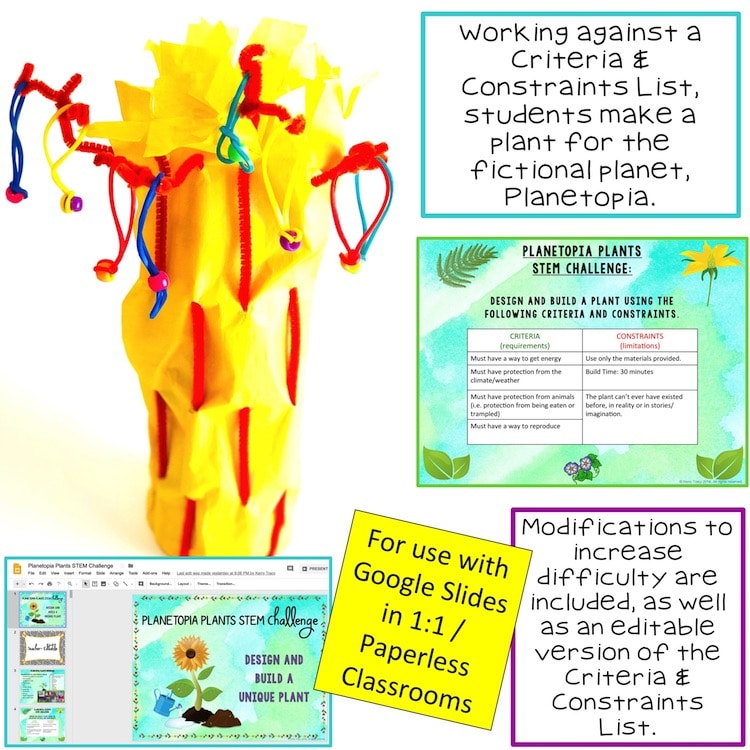Teaching about plants and need the perfect activity to engage? This STEM / STEAM Challenge is perfect for applying learning in plant needs, parts/functions, adaptations, life cycles, cells, photosynthesis, and/or genetics & heredity.
This STEM Challenge is great any time of the year, but works especially well as a spring activity! The completed designs and extension projects make beautiful displays for Back to School Night or Open House as well!
The basic premise:
Students work in individually or in partners or groups against a list of criteria and constraints to create a plant that has never been seen or imagined before. This challenge is part of the growing Planetopia Project series.
Note: The version you are viewing is compatible with Google Slides ™.
Click here for the printable version of this resource.
Resource includes:
- NGSS aligned standards, Grades 2 – 8
- Teacher Tips:
- Links to my 5-part video series on getting started with STEM challenges
- Materials and timing
- Criteria & Constraints (including modifications to increase difficulty for older students)
- Measuring results
- Universal STEM Challenge Notes & How to Use Student Slides
- Post-design extension activities list
- Link to a video walk-through of the challenge
- Student Handouts:
- Criteria & Constraints List (editable)
- Results and Design Analysis
- Discussion Questions
- Extension templates
- Process flow maps
- Create & solve math problems based on designs
- Plant Writing Templates
- Planetopia Plants Presentation Slides
- General Information
- Feature Spotlight
- Life Cycle
- Where in the World
- Genetics/ Heredity
- Plant Science Study Slides
- Plant Parts/Functions
- Photosynthesis
- Plant & Animal Cell Diagrams
- Plant & Animal Cell Compare/Contrast
- Plant Inquiry
Sample/suggested materials for each student or group:
(Materials you’ll need to do the activity are easily modified. You don’t need to provide all of the following materials. Select a subset and/or add in your own ideas.)
-
- Note: The links below are Amazon Affiliate links. Find out more on the disclosure page.
-
- Crayola Model Magic
- Tissue paper
- Construction paper
- Craft sticks
- Pipe cleaners
- Sequins
- Yarn
- Pom poms
- Paint
- Feathers
- Toothpicks
- Scissors
- Foil
- Cotton
- Felt
- Plastic beads
- Cotton
- Sand paper
- Small cups
- Rubber bands
- Paperclips
- Cardboard scraps
- Glue
- Masking tape
- Hot glue guns
- Uncooked noodles and/or beans
- Single hole punch
- Design analysis handouts (included in resource)
-
- Note: The links below are Amazon Affiliate links. Find out more on the disclosure page.
Benefits of this STEM Design Challenge:
- Focus on critical thinking, problem solving, and application of learning
- Helps students develop growth mindset traits like persistence and resilience
- High levels of student engagement
- The potential to hit upon all NGSS ETS standards depending on the depth and number of iterations you choose to implement in your classroom (modifications included)
- Highly flexible and differentiated for materials, timing, grade levels, and rigor.
Each design iteration should be planned for ~60 min. if you are including data gathering and analysis rather than just building for fun. If you add extension activities, you will need to adjust timing accordingly.
This resource is available in a printable format. It is also available in a discounted Planetopia Project bundle. The Digital/Paperless Mega Bundle is also coming soon!
If you prefer to purchase on TpT, click here.
Note: any coupon/promo codes for this site will only work on this site. TpT does not have the option for individual stores to offer promo codes.















Reviews
There are no reviews yet.